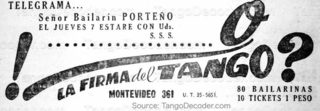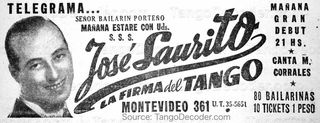 I've written before about Buenos Aires's so-called "taxi bars," which mimicked the famous dime-a-dance joints that had been popular in New York City since the 30s.
I've written before about Buenos Aires's so-called "taxi bars," which mimicked the famous dime-a-dance joints that had been popular in New York City since the 30s.  (Of course, the taxi bars of BsAs served tango as the musical main dish, while New York's originals were all about that swing.) Buenos Aires' homegrown taxi bars started showing up in the pages of "El Mundo" in 1943 with "El Palacio de Danza," where Guardia Vieja stalwart Amselmo Aieta led the house orchestra.
(Of course, the taxi bars of BsAs served tango as the musical main dish, while New York's originals were all about that swing.) Buenos Aires' homegrown taxi bars started showing up in the pages of "El Mundo" in 1943 with "El Palacio de Danza," where Guardia Vieja stalwart Amselmo Aieta led the house orchestra.
 Here is a June 1945 ad campaign from a competing establishment, "Montevideo 361," which debuted as "Gran Taxi Girl's" in October 1944 with Alberto Castillo at the mic. The first image in the trio is a "teaser" that appeared on Monday, 4 June 1945. It purports to be a telegram addressed to "Mr. Buenos Aires Dancer"; the message says "On Thursday the 7th I will be with you. Signed .............O, The Signature of Tango," followed by a big question mark that challenges the reader to guess who "The Signature of Tango" is. The big question mark and the guessing-game strategy evokes similar teaser ads that appeared in 1944 for "The Actor of Tango," who turned out to be Roberto Rufino.
Here is a June 1945 ad campaign from a competing establishment, "Montevideo 361," which debuted as "Gran Taxi Girl's" in October 1944 with Alberto Castillo at the mic. The first image in the trio is a "teaser" that appeared on Monday, 4 June 1945. It purports to be a telegram addressed to "Mr. Buenos Aires Dancer"; the message says "On Thursday the 7th I will be with you. Signed .............O, The Signature of Tango," followed by a big question mark that challenges the reader to guess who "The Signature of Tango" is. The big question mark and the guessing-game strategy evokes similar teaser ads that appeared in 1944 for "The Actor of Tango," who turned out to be Roberto Rufino.
So who/what was "The Signature of Tango"? It was the toothy fellow pictured in the second image (from Tuesday, 5 June 1945), whose given name was José Laurito. I had never heard of him before, and neither had Tango Decoder's friend and mentor Michael Lavocah, who did however point out that the singer named in the ad, M. Corrales, had recorded with the OTV (1939-40), had sung with Miguel Caló without recording, and would in 1951 join the orchestra of Carlos Di Sarli, changing his name at Maestro's suggestion to Mario Pomar. Thanks for that insight, Michael Lavocah ("El Caballero de la Historia del Tango")!
It seems that the Gran Taxi Girl's club, a.k.a. Dancing Girl's, a.k.a. Montevideo 361, was still going strong June 1945. So strong, in fact, that on Friday, 29 June, they could announce the installation of "Permanent Heating" (third image), offering their patrons the luxury of dancing at a consistent temperature of 28 degrees (82 F)! Now that's hot!
The "Permanent Heating" announcement doesn't bother to identify Laurito by name, only by his sobriquet, "La Firma del Tango," and that's in the fine print. After almost a month on the bandstand, whatever light his orchestra may have generated is eclipsed by the new heating system. His tenure at Montevideo 361 was to end two days later, when he would be replaced by "La Típica del Compás" and would promptly disappear into the fog of oblivion.
"Always remember, you are making history!"
:) Just when I wanted to chime in that the only name which sounds familiar is the original name of Mario Pomar's ... :)
Posted by: Dmitry | 02/16/2016 at 05:14 AM
Ten points, Dmitry! You da man.
Posted by: Michael | 02/16/2016 at 06:19 AM
And therefore not Mario Soto ;-)
Posted by: Aad de Danser | 02/17/2016 at 02:44 AM
Ten tickets, one peso.
I wonder how many tickets the men bought? As many as they could afford? How many could afford to spend two pesos? Or were ten dances enough over a few hours waiting a turn with the dancing girls?
Posted by: Jantango | 02/18/2016 at 01:15 PM
Corrected the Mario Soto/Pomar bit. I was writing about glosa-reciters at the same time, and Mario Soto was a glosador who worked with D'Agostino and later Laurenz. The name got stuck in my head. The error was mine.
Posted by: Michael | 02/19/2016 at 12:59 AM
How many tickets did the men buy, Jan? Probably a lot, if they really wanted to dance. At New York's Odeon dancehall, "one ticket" got you "one dance," but one dance was only one minute long. A buzzer sounded to mark the end of each dance. If you wanted to keep dancing, you had to give the woman another ticket. The BsAs taxi bars were modeled after the Odeon and similar NYC establishments.
We don't know for sure that the porteño taxi bars charged the same way, but we have a clue. The first ad that appeared for Gran Taxi Girl's (October 1944) offered "ten DANCES for one peso." A second ad, appearing the next day, amended that to "ten TICKETS for one peso." Presumably there had been some argument about what "one dance" was, and the latter formulation avoided that. When you put your money down, you were buying tickets, not dances. The value of a ticket was set by the management....
At that rate, you would need three or four tickets to dance one tango song with one of the "caras bonitas." That could get pretty pricey. One peso was about $3 USD in today's currency.
Let count the beans, then...
Ten tickets costing 1 peso are redeemed at a rate of one ticket per dance, and a dance is one minute long. If Mireya dances non-stop for one hour, how many tickets does she receive and how much revenue does that produce for the house? (This sounds like an SAT exam, doesn't it?) I figure she'd receive 50-60 tickets, with a revenue of 5-6 pesos, or $15-18. With 80, 100 or 150 dancers on tap, the owners would be raking in a lot of "ventolín."
Posted by: Michael | 02/19/2016 at 01:36 AM